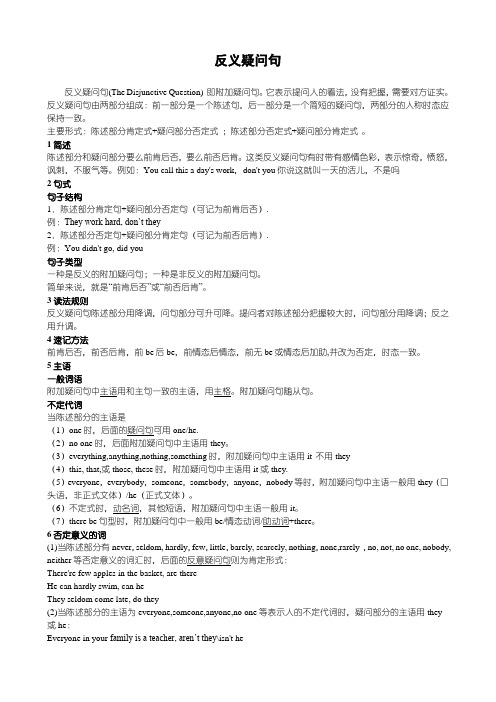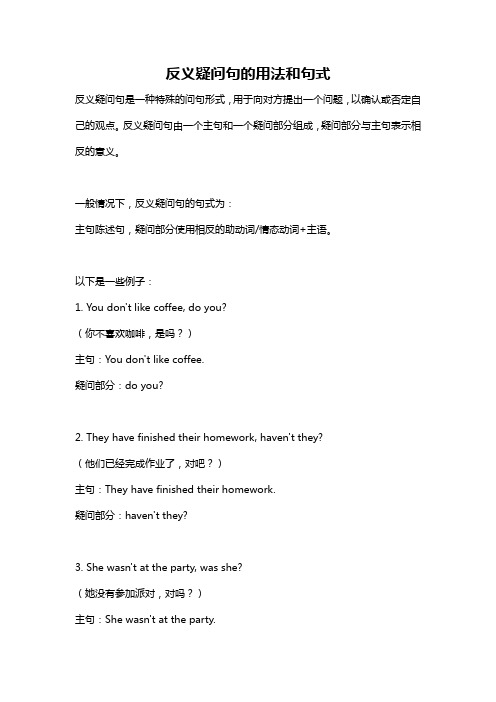Unit10 反意疑问句
初中英语反义疑问句详细讲解 整合

反义疑问句一、英文中的反意疑问句。
1、什么是反意疑问句英语中,反意疑问句是由陈述句和附在其后的附加疑问句组成。
其中附加疑问句是对陈述句所说的事实或观点提出疑问,起证实作用,一般用于证实说话者所说的事实或观点。
(表示说话者对某事有一定看法,但又不完全确定,需要对方加以证实。
)翻译为“是吗”2. 反意疑问句的回答,回答时,如果情况属实,用Yes加上反问句的倒装肯定句;若果情况不属实,则用No加上反问句的倒装否定句。
例如You were moved by your students, weren’t you?情况属实:Yes, I were. ?was情况不属实:No, I weren’t.注意事项:附加问句的主语应与陈述句的主语保持一致,且只能用人称代词替代。
如:You come from Beijing, don't you?你来自北京,是不是?The students in Grade One won't go to the park, will they? 一年级的学生不去公园了,是吗? 二、反意疑问句中问句部分的动词与陈述部分的动词在语气上成相反的对应关系,即:肯定+否定?否定+肯定?如:You can’t do it, can you? 你不能做它,是吗?They are very late for the meeting, aren’t they? 他们开会迟到了,是吗?三.当陈述句中含有be动词,助动词,或是情态动词时,反问句部分由这些词加上主语人称代词构成,Be动词包括:am, is, are, was, were助动词有:do, does, did, have(用在完成时), has(用在完成时)等情态动词有:can, could, may, might, must, will, would, shall, shoul例如:She is a lovely girl, isn’t she? 她是一个可爱的女孩,是吗?He will go home, won’t he? 他要回家了,是吗?She doesn’t l ike to eat popcorn, does she? 她不喜欢吃爆米花,是吗?The baby won’t sleep early, will it?小宝宝睡得不早,是吗?注意:He has supper at home every day,doesn’t he? (不能用hasn’t he?)他每天在家吃晚饭,是吗?They have known the matter, haven’t they? (不能用don’t they?)他们已经知道那事情了,是吗?四.当陈述句中只含有行为动词时,若动词加了s,就用does, 若动词为原形,就用do,动词为过去式,则用did,例如:You cleaned your house last week, didn’t you?你上周打扫了你的房间,是吗?Your father plays the computer very well, doesn’t he ?你父亲电脑技术很好,是吗?They look so happy today, don’t they?你今天看起来很高兴,是吗?五.(1)反意疑问句的陈述部分带有little, few, never, hardly, seldom,nobody, nothing, no one, none, neither, barely, scarcely等否定意义的词时,问句部分用肯定式。
高中英语反义疑问句

反义疑问句反义疑问句(The Disjunctive Question) 即附加疑问句。
它表示提问人的看法,没有把握,需要对方证实。
反义疑问句由两部分组成:前一部分是一个陈述句,后一部分是一个简短的疑问句,两部分的人称时态应保持一致。
主要形式:陈述部分肯定式+疑问部分否定式;陈述部分否定式+疑问部分肯定式。
1简述陈述部分和疑问部分要么前肯后否,要么前否后肯。
这类反义疑问句有时带有感情色彩,表示惊奇,愤怒,讽刺,不服气等。
例如:You call this a day's work,don't you你说这就叫一天的活儿,不是吗2句式句子结构1.陈述部分肯定句+疑问部分否定句(可记为前肯后否).例:They work hard, don’t they2.陈述部分否定句+疑问部分肯定句(可记为前否后肯).例:You didn't go, did you句子类型一种是反义的附加疑问句;一种是非反义的附加疑问句。
简单来说,就是“前肯后否”或“前否后肯”。
3读法规则反义疑问句陈述部分用降调,问句部分可升可降。
提问者对陈述部分把握较大时,问句部分用降调;反之用升调。
4速记方法前肯后否,前否后肯,前be后be,前情态后情态,前无be或情态后加助,并改为否定,时态一致。
5主语一般词语附加疑问句中主语用和主句一致的主语,用主格。
附加疑问句随从句。
不定代词当陈述部分的主语是(1)one时,后面的疑问句可用one/he.(2)no one时,后面附加疑问句中主语用they。
(3)everything,anything,nothing,something时,附加疑问句中主语用it 不用they(4)this, that,或those, these时,附加疑问句中主语用it或they.(5)everyone,everybody,someone,somebody,anyone,nobody等时,附加疑问句中主语一般用they(口头语,非正式文体)/he(正式文体)。
英语反义疑问句的问句与回答归纳

英语反义疑问句用法讲解一、基本概念及结构:反义疑问句又叫附加疑问句,是指当提问的人对前面所叙述的事实不敢肯定,而需要向对方加以证实时所提出的问句。
其结构为:前一部分是一个陈述句,后一部分是一个简短的问句。
完成后一部分简短问句时,要根据前面陈述句的动词时态和人称来选择适当的助动词进行提问,前后两部分的人称和动词时态要保持一致。
如果前一部分用肯定式,后一部分一般用否定式;反之,前一部分为否定式,后一部分要用肯定式,即“前肯定后否定,前否定后肯定”。
例如:You don’t like rock music, do you 你不喜欢摇滚乐,对吧二、反义疑问句的回答不管是前否后肯,还是前肯后否形式的反义疑问句,回答都根据事实回答,肯定的答案就用yes+肯定结构,否定的答案就用no+否定结构,答案要和实际情况相符。
也叫实事求是例如:1、--She is good at English, isn't she--Yes, she is. 是的,她擅长或者No, she isn't.不,她不擅长2、--There isn't a computer in your r oom, is there“你的房间里没有电脑,对吗?-- Yes, there is.不,有电脑或者 No,there isn't.是的,没有电脑。
三、其他规则:1、陈述部分用否定词或半否定词 no , nothing, nobody, never, few, seldom, hardly, rarely, little 等否定含义的词时,疑问部分用肯定形式。
例如:He is never late for school, is he?他上学从不迟到,是吗2、陈述部分的谓语是used to 时,疑问部分用didn’t +主语或 usedn’t +主语。
例如:He used to take pictures there, didn’t / usedn’t he 他过去常常在那儿拍照,是吗You used to sleep with the windows open, usedn’t/ didn’t you你过去常常开着窗户睡觉,是吗?3、陈述部分为祈使句时,祈使句后加附加问句,不表示反意,而表示一种语气。
Unit10反意疑问句

邓双胜
反意疑问句
反意疑问句又称附加疑问句,在一个陈述句 之后附上一个简短的疑问句,对陈述句提 出相反的疑问,这种疑问句叫反意疑问句。
1. He isn’t talking, is he? 2. We speak Chinese, don’t we?
结构:陈述句+简短的一般疑问句
具体规则 1.前肯后否,前否后肯 陈述句(前句)是肯定时,反意问句(后句)就用 否定;前句是否定时, 后句用肯定. isn’t This story is scary, ______ it? This story isn’t scary, _____ it? is 2.前、后两句要注意时态,人称的一致. 3.后句一定要用缩写的简略式
3.前句主语是this, that, everything, nothing, something等时,后句用it;
前句主语是these, those时,后句用they.
isn’t it This is a useful tool,_______? is it Nothing is wrong with the radio, ______? are they These \Those aren’t notebooks,________?
10.否定前缀不能视为否定词,其反意疑 问句仍用否定形式。
isn't it It is impossible, __________?
isn’t he Tom is impolite to others,_______?
doesn’t he He dislikes it, __________? aren’t they They are unhappy now ,___________?
初中英语反义疑问句归纳总结大全

反义疑问句1,反义疑问句的基本形式常见的反义疑问句分为前肯后否和前否后肯两种形式,即如果陈述部分是肯定结构,反义疑问句部分就用否定结构,反之亦然。
反义疑问句部分主要用代词,并与前句主语一致谓语动词在人称,数,和时态上也要与前句一致.He goes to work on foot, doesn’t he?2,反义疑问句部分主语及谓语的确定简略问句部分主语与谓语的确定应以陈述部分的主语和谓语为依据,尤其要注意一些特殊的情况。
同时,简略问句部分的主语一般应用人称代词,而动词若为否定形式,则一般应用缩略形式。
(1)当陈述部分的主语为this, that,则用it。
当these,those时,则用they。
This is a green jeep,isn’t it?Those aren't banana trees, are they?(2)当陈述部分为I am形式时, 附加问句用aren’t I.I'm right, aren’t I?(3)当陈述部分是There be结构时,用be there。
There was an English film yesterday,wasn’t there?(4)当陈述部分有never,seldom,no,few,little, nothing, nobody, hardly,none,too…to。
等表示你否定意义的词时,反义疑问部分用肯定形式。
He seldom goes to the cinema,does he?(5),如果陈述部分含有表示否定意义的由前词缀或后缀构成的词(dislike,unfair,unhappy, careless,unlike,impossible,impolite, impossible等),疑问部分用否定形式。
She dislikes the idea, doesn't she?It’s unfair,isn’t it?(6)主语是不定代词的反义疑问句1)当陈述部分的主语为everthing,nothing,anything, something等指事/物的不定代词时,疑问部分主语用it,而不用they。
Unit 10反义疑问句

2
3
4
5
6
7
f b e a d c g
What have we learned ?
反意疑问句
前肯后反, 前反后肯.
前一句是肯定句, 反意疑问句用否定
isn’t it It’s a cool day, ___________? Ben is a clever boy, ______________? isn’t he can’t he He can play the piano, ____________? doesn’t it It often rains on weekend, ____________? aren’t you You are a student, _____________? hasn’t she She has eaten lunch, ______________? didn’t he He failed the exam, _____________? won’t he Jim will go to the party, ___________? isn’t there There is much fun there,_____________?
Yes, he can.
isn’t there There is an egg in the picture,_________?
No, there isn’t.
wasn’t there
There was a heavy snow yesterday, ________?
Yes, there was.
How to make a small talk(闲谈)?
At the bus stop
isn’t it It’s a fine day, ___________? isn’t it This is great weather, ___________? The bus comes so late, __________? doesn’t it isn’t it The line is so long, __________?
Unit 10 反义疑问句 及 知识点

Unit 10 It ’s a nice day, isn ’t it?一、反义疑问句概念:在一个陈述句之后附上一个简短的疑问句,对陈述句提出相反的疑问,这种疑问句叫反意疑问句。
如:1. Flue is scary, isn’t it ? 流感很恐怖,不是吗?2. We speak Chinese, don’t we ? 我们讲汉语,不是吗?二、反意疑问句结构:结构一:前肯,+ 后否 即:陈述部分是肯定句,疑问部分用否定结构。
eg. SARS is scary, isn’t it?结构二:前否,+ 后肯 即:陈述部分是否定句,疑问部分用肯定结构。
eg. Flue isn’t scary, is it?但也有部分特殊情况,请详记!1. 当陈述句主语为下列情况,疑问部分主语需做相应变化:①This is an umbrella, ____________ _______? ② These are mice, ____________ ___________? ③ There is too much traffic in the street, __________ ______? ④ To see is to believe, ___________ ___________? ⑤ Something is wrong with the robot, _________ _________? Everything goes well, _____________ ____________? ⑥ Someone has taken away my dictionary, __________ ______? Nobody has come along until now, _________ __________?2. 当陈述部分为下列情况时, 疑问部分需做相应变化:① I ’m an astronaut, _____________ _____________? ② I ’m not a collector, _____________ _____________? ③ Let ’s look through today ’s newspaper, ___________ __________? ④ Let us cross the river, ______________ ____________? ⑤ Let me turn down the music, ________________ _____________? ⑥ Don ’t cut in line, ______________ _________________?3. 陈述句中含有not, no, nothing , nobody, never, hardly, seldom (很少), neither, few, little, too …to 等否定词时, 疑问部分常用肯定形式。
反义疑问句的用法和句式

反义疑问句的用法和句式
反义疑问句是一种特殊的问句形式,用于向对方提出一个问题,以确认或否定自己的观点。
反义疑问句由一个主句和一个疑问部分组成,疑问部分与主句表示相反的意义。
一般情况下,反义疑问句的句式为:
主句陈述句,疑问部分使用相反的助动词/情态动词+主语。
以下是一些例子:
1. You don't like coffee, do you?
(你不喜欢咖啡,是吗?)
主句:You don't like coffee.
疑问部分:do you?
2. They have finished their homework, haven't they?
(他们已经完成作业了,对吧?)
主句:They have finished their homework.
疑问部分:haven't they?
3. She wasn't at the party, was she?
(她没有参加派对,对吗?)
主句:She wasn't at the party.
疑问部分:was she?
4. He can't swim, can he?
(他不会游泳,对吗?)
主句:He can't swim.
疑问部分:can he?
需要注意的是,在反义疑问句中,疑问部分的助动词/情态动词与主句的时态和人称保持一致,并使用正式陈述的词序(即将助动词/情态动词置于主语之前)。
同时,反义疑问句通常用于口语交流中,以期望得到对方的确认或否定。
- 1、下载文档前请自行甄别文档内容的完整性,平台不提供额外的编辑、内容补充、找答案等附加服务。
- 2、"仅部分预览"的文档,不可在线预览部分如存在完整性等问题,可反馈申请退款(可完整预览的文档不适用该条件!)。
- 3、如文档侵犯您的权益,请联系客服反馈,我们会尽快为您处理(人工客服工作时间:9:00-18:30)。
Grammar:反意疑问句
一、构成:陈述句,+简单问句
如果陈述句是肯定句,简单问句则用否定形式。
It is a nice day, isn ’t it?
简单问句的构成:
Is it a nice day?
如果陈述句是否定句,简单问句则用肯定形式。
It isn ’t a nice day, is it?
→Is it ? Isn ’t it a nice day? →Isn ’t it ?
Does he go to school by bike every day?→Does he ?
1.简短问句的否定形式,要用缩写形式,不能出现not,主语要用人称代词不能用名词.
Her mother is a doctor , isn‘t she?
There is a book on the desk, isn't there? 2.对反意疑问句的回答,是根据事实,而不是根据问题的提法。
He isn‘t a doctor, is he ? (他不是医生,是吗?)
Yes, he is . (不,他是医生。
)
No, he isn't. (是的,他不是医生。
)
1. 陈述部分是I am 或I ’m 时,疑问部分用aren ’t I I am strong and healthy, aren't I?
2.陈述部分有no , never, few, little 时,疑问部分用肯定
3.陈述部分主语是there, this, that , these, those 疑问部分用there , it ,they
4.陈述部分主语是everyone, everybody, someone, somebody, anybody, no one, nobody 等时,疑问部分用they, he ;陈述部分是everything, something, nothing ,anything 时,疑问部分用it
5.祈使句的反意疑问句用will you , 或shall we
6.宾语从句中,以主句为准,但如果主语是第一人称且谓语动词是think, believe 等时,以从句为准
(1)You ’re a farmer, _______ ________?
(2)The weather isn ’t fine, ______ _____?
(3)Kate came here last month, _____ ______?
(4)I don ’t think Tom is at home, _____ _____?
(5)There weren ’t enough nuts, _____ _____?
(6)There ’s a pen in the pencil-box, ____ _____?
(7)The man had bread for lunch, ______ ____?
(8)Mary can speak little English , _____ ______?
(9)Nothing is wrong with the watch, ____ _____?
完成下列反意疑问句
aren ’t you is it didn ’t she is he were there isn ’t there didn ’t he can she is it
①The boy is Japanese, ______he?
②The book isn't interesting, ______ it?
③He knows a lot about English names, ______ he?
④The girl doesn't like apples, ______ she?
⑤There are two birds in the tree, ______ there?
⑥The man came to China last month, ______ he?
Fill in the blanks:
isn't is doesn't does aren't didn't
顺口溜
反意反意意相反,陈述、问句一起来. 这种句子真奇怪, 前面有be 后用be , 无be 可用助动词, 具体时态要分清。
特殊形式要牢记,I ’m 变成aren ’t I, never 等词表否定. 不定代词要分开, 事物it 人有二, they 与he 皆可用。
祈使句分两种, 一般情况will you , let ’s 开头shall we,回答句子要看清, 符合事实用yes , 中文翻译要注意!。
